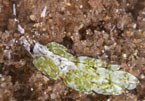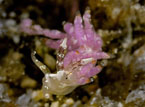| Home |
| Acknowledgments |
| Conventions |
| Glossary |
| Maps |
| References |
| Links |
| Articles |
| Thumbnails |
| Species
list |
| Family |
| Next
species |
Additional Photos

side

cerata spots

less white

green

violet

young

feeding

mating

Favorinus sp. #2

| Maximum size: 6-7 mm. Identification: This is a translucent-cream species with long, smooth cerata and two to three swellings on its rhinophores. The smooth cerata distinguish it from Favorinus japonicus and Favorinus sp. #1. The body and cerata are usually frosted with cloudy white pigment and there are often brown flecks on the rhinophore bases. Small, orange-brown spots are usually present in the tips of the cerata. (Note 1) As with other members of the genus, the background color is determined by diet, usually ranging from white to green to violet. Natural history: Prior to 2020, Favorinus sp. #2 was known from one animal found at a depth of 5-6 m (16-20 ft) at a moderately protected, rocky site. Since then, several animals have been found on sand at 3-9 m (10-30 ft) at moderately exposed sites. As with other members of the genus, it feeds on the egg masses of other opisthobranchs. (Note 2) Distribution: Big Island, Maui and Oahu. Taxonomic notes: It was first recorded in Hawaii from Napili Bay, Maui by CP on Nov. 2, 1995. Photo: Jenna Szerlag: 6-7 mm: Maalaea Bay, Maui; Aug. 28, 2023. Observations and comments: Note 1: The orange-brown pigment appears to be deposited in the tip of the digestive gland and to be independent of pigments in the egg masses that they're eating. Note 2: From the available photos, perhaps this species specializes in cephalaspidean egg masses? The white/brown, green and violet background colors might support this since various cephalaspidean egg masses range from clear to green to violet. The most likely source for green pigment is Unidentified Haminoeid #2. The most likely source for violet pigment is Diniatys dentifer. |
| Thumbnails |
Species
list |
Family | Next species | Top |